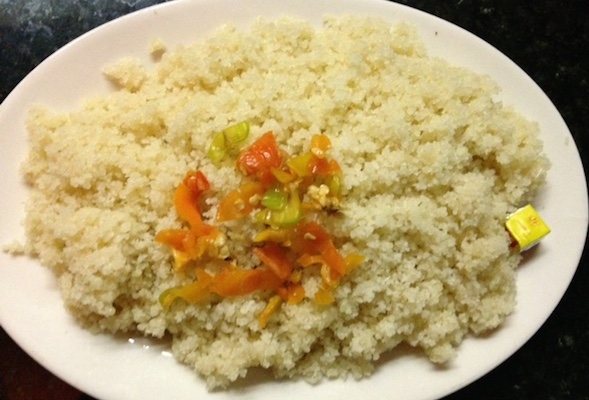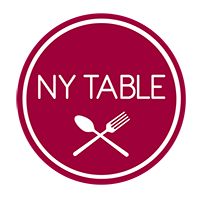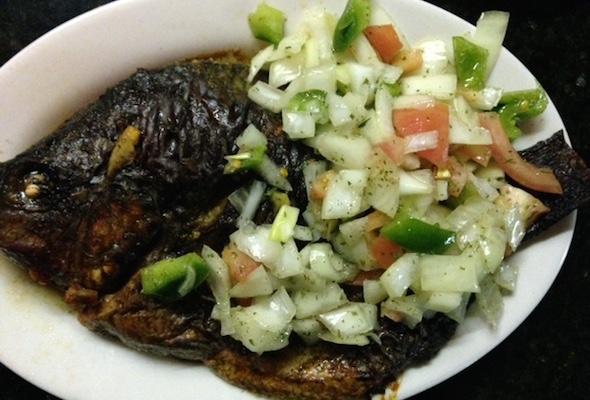A taste of home

Attiéké or boiled and ground cassava is one of the main dishes eaten in the Ivory Coast. Photo: Ayana Osson.
A group of men sit around at a long table on a cold winter night, talking loudly in a mixture of French and Mandingo, a native dialect in West African countries. A rerun of the Africa Nations Cup soccer championship plays on a flat screen television mounted on a wall a few feet away, and they watch with great pride and enthusiasm as their homeland, the Ivory Coast, beat Ghana, even though they had already watched the game when it first aired a day earlier.
The men, most of them cab drivers, gather at New Ivoire, a tiny Ivorian restaurant on East 119th street in East Harlem — the first of only three Ivorian restaurants in the city, and, since its opening in 1996, a favorite among both Ivorians and members of the East Harlem community.
New Ivoire stands out on a small residential block, its brick exterior painted in orange, white, and green stripes, the colors of the Ivorian flag. Even at midnight, the restaurant, which is open 24 hours, seven days a week, is buzzing with life. Inside, the restaurant’s walls are orange, green and white as well. In the middle of the 40-seat restaurant sit five rows of square tables and chairs, some squeezed together to accommodate larger groups of diners. New Ivoire’s owner Cheick Cisse, 42, stands behind a tall counter when he isn’t dining at one of the tables with his loyal guests.
Cisse, one of about 15,000 Ivory Coast immigrants living in the New York City metro area, emigrated in 1996, after his older brother sent for him. He worked at a Bronx gas station for a year and a half before he started driving a cab – and he became a regular at New Ivoire, which was then owned by one of his friends. When he heard that the restaurant was in jeopardy of closing, in 2006, Cisse decided to refinance his home and take it over. Although he had no previous restaurant experience, he was suddenly the owner, manager and waiter. Working 12-hour shifts, six days a week, Cisse learned how to run a restaurant on the job. He keeps his business small, with only two waitresses and four cooks, who prepare food daily. On busy days Cisse helps out in the kitchen by making fried foods and waiting tables.
“Working six days a week is very tough,” he said. “But you don’t have a choice, because this is your place and you don’t trust too many people.”
Now, with almost 10 years of restaurant experience under his belt, Cisse works less — 12-hour shifts four days a week — and his brother helps him out. When he is not at the restaurant, Cisse spends time with his wife and three children, who normally don’t like to come to the restaurant because of the noise.
When New Ivory isn’t busy, Cisse eats with his guests. He knows almost every regular at his restaurant and enjoys laughing and interacting with them; he treats them like his friends, and in fact many of them are. On a slow Tuesday night,with only three diners present, Cisse sits down with a cab driver who is taking a break from work. The two men chat loudly over a plate of attiéké, or steamed cassava, an iconic Ivorian dish. Attiéké is white and clumpy, similar in appearance to cous cous, with a slightly bitter flavor, and usually served as a side dish with diced tomatoes, onions and peppers. According to Cisse, attiéké is eaten traditionally with the right hand, in the belief that the left hand is used for washing, but he feels that the food has a better flavor when mixed with both hands instead of utensils.
Cisse serves a large portion of his best-selling dish with Maggi, a seasoning cube used to add flavor to meat, on the side, which is broken off and ground on top and then mixed into the hot dish. Though many Ivorians prefer their food to be spicy, Cisse leaves the seasonings, like a mixture of diced peppers, on the side, to accommodate guests who have may health issues or don’t like their food with much seasoning.
New Ivoire serves more than 20 dishes that are native to the Ivory Coast. The lunch menu, listed in both English and French, changes daily to provide a variety of soups and stews, meats, and side dishes ranging from $11 to $15. There might be Sauce Claire, a light tomato soup served with din don fumeé, or smoked turkey fowl or queue de boeuf, which is oxtail. The thin, spicy brownish-red soup comes with the customer’s choice of meat placed in the middle of the bowl. It also comes with white rice, cous cous, or attiéké, for which the broth serves as a sort of gravy. Later on in the day, customers can choose from heftier meals, and, starting at four o’clock in the morning, New Ivoire serves breakfasts that include spaghetti with tomato sauce, petit pois –green peas — mixed with onions and tomatoes, and a ground beef sandwich.
The 24-hour menu and range of food is convenient for many regulars who work unconventional hours. Cab driver Salim Diallo, 35, finds New Ivoire a good choice because he lives alone and does not cook. Diallo, who moved to New York from Mali four years ago, eats there almost every day, sometimes multiple times a day, because the food reminds him of food he grew up eating in Mali.
“I like coming here,” he said. “I get good food and have a lot of friends here.”
New Ivoire is more of a hangout spot for regulars like Ciise Abdul, 40, who comes here to interact with friends. Abdul, who is from the Ivory Coast, works as a line cook five days a week, but visits New Ivoire when he has spare time. He occasionally ends up spending most of the day, to chat and catch up with friends.
“I come to this restaurant because I’m African and things that I grew up with I can get here,” he said. “Every time I’m off [from work] I come here, sit with people and talk. I enjoy myself.”


Your Comments